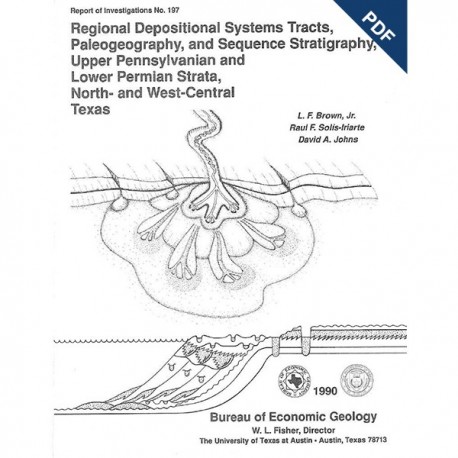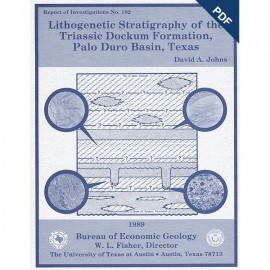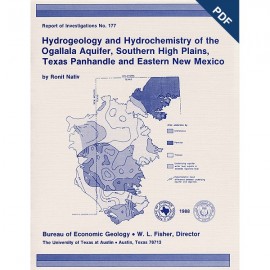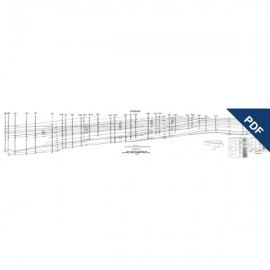Reports of Investigations
-
Books & Reports
- Reports of Investigations
- Guidebooks
- Udden Series
- Geological Circulars
- Down To Earth
- Atlases of Major Oil and Gas Reservoirs
- Texas Memorial Museum Publications
- Environmental Geologic Atlas of the Texas Coastal Zone
- Mineral Resource Circulars
- Other Reports
- Seminars and Workshops
- Handbooks
- Submerged Lands of Texas
- Symposia
- Annual Reports
- Open File Reports
-
Maps & Cross Sections
- Thematic Maps
- Miscellaneous Maps, Charts & Sections
- Geologic Atlas of Texas
- STATEMAP Project Maps
- Geologic Quadrangle Maps
- Cross Sections
- Highway Geology Map
- Energy and Mineral Resource Maps
- Shoreline Change and Other Posters
- Wilcox Group, East Texas, Geological / Hydrological Folios
- Bouguer Gravity Atlas of Texas
- River Basin Regional Studies
- Featured Maps
- Posters
- Teachers & the Public
-
Geological Society Publications
- Gulf Coast Association of Geological Societies
- Alabama Geological Society
- Austin Geological Society
- Corpus Christi Geological Society
- Houston Geological Society
- Lafayette Geological Society
- Mississippi Geological Society
- New Orleans Geological Society
- South Texas Geological Society
- GCS SEPM Publications
- Historic BEG & UT Series

Regional Depositional Systems Tracts, Paleogeography, and Sequence Stratigraphy... Digital Download
RI0197D
RI0197D. Regional Depositional Systems Tracts, Paleogeography, and Sequence Stratigraphy, Upper Pennsylvanian and Lower Permian Strata, North- and West-Central Texas, by L. F. Brown, Jr., R. F. Solis-Iriarte, and D. A. Johns. 116 p., 43 figs., 2 tables, 27 pls., 1990. doi.org/10.23867/RI0197D. Downloadable PDF; not available in book format.
To purchase this publication on CD, please order RI0197CD.
ABSTRACT
Sixteen depositional sequences, commonly called cyclothems, each composed mostly of limestone(retrogradational/transgressive) and siliciclastic (progradational/regressive) subsequences, or systems tracts, record the paleogeography during Late Pennsylvanian (Virgilian Epoch) and Early Permian (Wolfcampian Epoch) Periods on the Eastern Shelf and adjacent Midland Basin, North-Central Texas. Virgilian and Wolfcampian Series, ranging in total thickness from about 1,200 ft (365 m) in updip parts of the Eastern Shelf to more than 2,800 ft (853 m) along the eastern margin of the Midland Basin, were deposited under the influence of several regional tectonic foreland elements, diverse source areas, variable subsidence, and glacio-eustatic sea-level variations. To understand eventually the respective effects of local sedimentary dynamics, regional tectonic events, and global sea-level variations on the depositional history of these strata, it is necessary to understand their lithogenetic and sequence stratigraphy. Consequently, stratigraphic cross sections covering approximately 2,000 mi (3,200 km), extensive outcrop data, and 5,135 wells were used to interpret and map depositional systems tracts composing highstand and lowstand terrigenous clastic subsequences within 22,000 mi2 (57,000 km2). Sandstone isolith and paleogeographic maps and their sequence-stratigraphic interpretation are the principal contributions of this report. Specific goals were to (1) provide regional net-sandstone distribution within each regressive episode, (2) documentsequential depositional history, (3) outline depositional systems and paleogeography for each regressive episode, (4) analyze depositional response to paleobathymetry and tectonics, and (5) offer a regional sequence-stratigraphic framework with which to unify diverse data that may contribute to a better understanding of the interplay of factors that controlled cyclic changes in relative sea level.
Fully developed siliciclastic highstand subsequences are composed of (proximal to distal) fluvial and interfluvial, platform deltaic and interdeltaic, shelf, and, rarely, slope-basinal systems tracts. Lowstand subsequences consist of entrenched valley fills, basin-floor fans, leveed-slope fans, and prograding deltaic slope wedges. These systems tracts document deltaic progradations (regression) across the Eastern Shelf during late rising and early falling relative sea level to establish highstand shorelines, which were followed by falling relative sea level that shifted shorelines to lowstand positions typically basinward and below preexisting shelf edges. Regional sandstone isolith maps outline skeletal elements of highstand and lowstand sediment dispersal systems composed of low- to high-sinuosity meanderbelt, distributary channel-fill, elongate and lobate delta-front, incised valley-fill, slope channel-fill and levee, and submarine-fan facies. Enclosed within respective alluvial-plain, deltaic-plain, prodeltaic, slope, and basinal mudstones, these sandstones constitute the principal reservoirs in the region.
Stratigraphic relationships within sequences infer principally Type 1 relative changes of sea level. Cyclic episodes began with a relative fall of sea level that entrenched rivers across highstand coastal plains and shelves and eroded submarine canyons to produce Type 1 unconformities; basin-floor fans were deposited on the unconformities. When relative sea-level fall diminished and slow rise began, lowstand leveed-slope fans and deltaic-slope wedge systems prograded into the Midland Basin. Accelerating relative rise of sea level eventually flooded and locally eroded the lowstand deltaic plains and ultimately the highstand coastal plains. Paracyclic sea-level rise produced retrogradational systems that coastally onlapped the Type 1 unconformities, constituting transgressive systems tracts. Catch-up and keep-up limestone deposition reflects aggradation and progradation during paracyclic rises and stillstands. Depending upon available sediment, more proximal deltaic/interdeltaic systems likewise exhibited retrogradation: flooding during rises, prograding during stillstands, and at times contributing muddy suspension plumes that helped to suppress shelf limestone deposition. Maximum midrise rate of relative sea level (1) diminished photic and thermal energy and essentially eliminated shelf limestone deposition; (2) induced sediment starvation, permitting anoxic conditions to spread from the Midland Basin onto slopes and shelves; and (3) resulted in maximum shoreline transgression that coincided with final deposition of thin, marine-condensed sections composed of dark, fossiliferous shales or updip equivalents. During late, decelerating relative sea-level rise, estuaries filled and highstand deltaic/interdeltaic systems prograded (downlapped) across the shelves while proximal fluvial systems coastally onlapped basin margins. Paracyclic progradation and aggradation continued until the rate of rapidly falling eustatic sea level exceeded the rate of subsidence at the shelf edge to produce a rapid fall of relative sea level that again initiated Type 1 erosion.
Tentative mechanisms to explain Virgilian and Wolfcampian cyclic deposition may involve a complex interplay of regional tectonics (differential subsidence and marginal uplift) and intraplate compressional events; eustatic variations resulting from glaciation, geoidal effects, and plate adjustments; and localized and secondary processes such as sediment supply, deltaic shifting, differential compaction, and growth faulting. Present evidence supports this cyclic model: (1) incised, commonly meandering, valley-fill systems in outcrop and across the Eastern Shelf; (2) deltaic wedges that occur basinward and well below preexisting shelf edges within erosionally enhanced shelf-edge notches; and (3) sandstone isolith contour patterns that distinctly define distal limits of bifurcating highstand deltaic systems, exposed shelves with entrenched straight fluvial channels, and isolated lowstand prograding wedges and basin-floor fans. Further verification of the Type 1 unconformities will require detailed analysis of well logs and, perhaps, high-resolution seismic data.
During early Virgilian highstand and lowstand depositional episodes, terrigenous clastic depositional systems tracts were generally restricted to the moderately subsiding, relict Home Creek shelf. By mid-Virgilian, highstand tracts were widespread on the Eastern Shelf, and lowstand systems were depositing directly into the Midland Basin. During late Virgilian and early Wolfcampian, shelves became shallower and more stable, resulting in deposition of thin siliciclastic highstand tracts principally on interior and middle parts of the Eastern Shelf; lowstand fluvial systems deeply entrenched exposed shelves, and well-developed basin-floor fans and prograding wedges were deposited below respective shelf edges. Thicker limestone highstand and retrogradational deposition generally coincided with more stable outer shelves. By late Wolfcampian, shelves began to subside more rapidly, resulting in well-developed siliciclastic highstand systems on interior parts of the Eastern Shelf and small lowstand systems along shelf edges. Diminishing terrigenous sediment supply eventually permitted thick highstand limestone deposition to dominate by increased shelf subsidence and sediment accommodation.
Application of lithogenetic and sequence-stratigraphic concepts may lead to reexploration in this mature basin-for example, structural/stratigraphic traps of growth-faulted, lowstand delta-front facies; updip stratigraphic traps of lowstand deltaic sandstone facies; and stratigraphic traps of canyon-fill and basin-floor fans. Further verification and refinement of the proposed sequence-stratigraphic model will be necessary to permit full application of the concepts in future stratigraphic exploration.
Keywords: cyclic deposition, depositional systems tracts, Eastern Shelf, eustasy, Midland Basin, North-Central Texas, paleogeography, relative sea level, sequence stratigraphy, Virgilian and Wolfcampian Series
Citation
Brown, L. F., Jr., Solis-Iriarte, R. F., and Johns, D. A., 1990, Regional Depositional Systems Tracts, Paleogeography, and Sequence Stratigraphy, Upper Pennsylvanian and Lower Permian Strata, North- and West-Central Texas: The University of Texas at Austin, Bureau of Economic Geology, Report of Investigations No. 197, 116 p.




